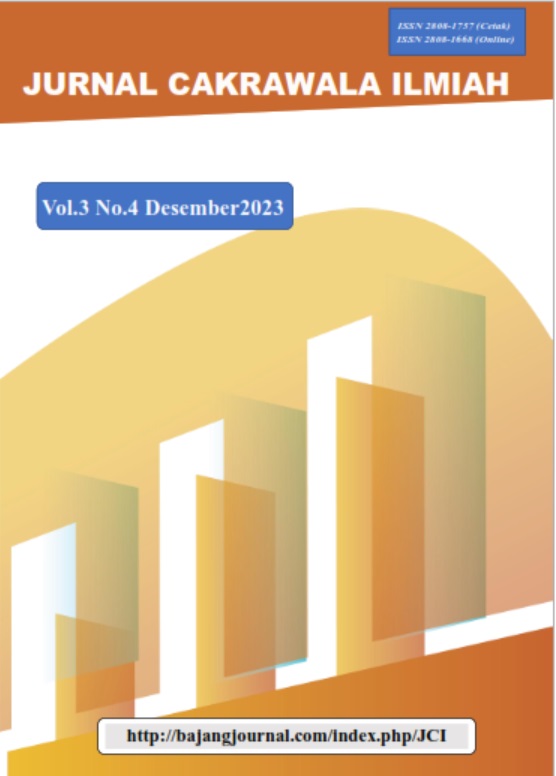DOWNHOLE MONITORING SUMUR GEOTHERMAL DENGAN METODE PRESSURE TEMPERATURE SHUT-IN SUMUR SR 1#2 DI PT PERTAMINA GEOTHERMAL ENERGY AREA LUMUT BALAI
DOI:
https://doi.org/10.53625/jcijurnalcakrawalailmiah.v3i4.7048Keywords:
Pressure Temperature (PT), Feedzone, EPCCAbstract
SR 1#2 well is one of the Shut-in status production wells owned by PT Pertamina Geothermal Energy Area Lumut Balai which will be used for the supply of Steam PLTP Lumut Balai Unit II which is in the Engineering, Procurement, Construction, Commissioning (EPCC) stage. Downhole Monitoring activities are carried out to find out the latest data from SR 1#2 wells using the pressure temperature shut-in method. The measurement carried out on April 3, 2023 is a continuation of the pressure temperature shut-in program that was previously carried out in 2014, to process data and analyze the results of the pressure temperature shut-in. The results obtained from processing downhole monitoring data with the Pressure Temperature shut-in method using excel with the VLOOKUP formula and manual calculations, on April 3, 2023, the highest temperature was obtained at 233.67oC and pressure 84.02 bar at a depth of 1770 mKU and the results of the analysis of the Pressure Temperature Shut-in graph on April 3,2023 based on Shut-in Pressure Temperature comparison data in the previous year, namely on July 7, 2013 the highest pressure and temperature were at (88.92 bar and 235.93oC), on May 11, 2014 the highest pressure and temperature were at (85.94 bar and 232.91oC) and on April 3, 2023 with a span of 9 years the highest pressure and temperature at (84.02bar and 233.67oC) Then it can be concluded that the feedzone and reservoir from the SR 1#2 well have not experienced significant changes and will be used as a steam supply for PLTP unit II.
References
Akbar, A. R., Kasmungin, S., & Kustono, B. (2017, October). Analisis Data Pts (Pressure, Temperature, Spinner) Setelah Dilakukan Kegiatan Acidizing Pada Sumur Abl-1. In Prosiding Seminar Nasional Cendekiawan (pp. 1-6). Indonesia.
Dickson, M. H., & Fanelli, M. (2013). Geothermal energy: utilization and technology.
Guidance Handbook Operation Pembangkit Listrik Tenaga Panas Bumi Lumut Balai Unit 1 (1 x 55 MW)
Hochstein, M. P.(1990). Classification and assessment of geothermal resources. Small geothermal resources: A guide to development and utilization, UNITAR, New York, 31-57.
Lubis, D. A. (2022). Pengembangan Lapangan Geothermal Dengan Analisis Uji Produktivitas Sumur Menggunakan Metode Uji Sembur Datar Pada Sumur X Lapangan Geothermal Sorik Marapi (Doctoral dissertation, Universitas Islam Riau).
Narendrodhipo, I., Kasmungin, S., & Kustono, B. (2017, October). Analisa Survei Pts Flowing Untuk Menentukan Produktivitas Sumur Panas Bumi Menggunakan Wellbore Simulator. In Prosiding Seminar Nasional Cendekiawan (Pp. 118-123). Indonesia.
Ramadhan, Fahmi dan Bambang Kustono. 2015. Analisis Hasil PTS Survey pada Saat Komplesi untuk Menentukan Zona Produksi Sumur “X” Lapangan Wayang Windu. Seminar Nasional Cendikiawan.indonesia.
Saptadji, N. M. (2001). Teknik Panas Bumi. Bandung, Penerbit ITB.
Steingrimsson, Benedikt, 2013, Geothermal Well Logging: Temperature And Pressure Logs, United Nations University
Steven, Lynell. 2000. Pressure, Temperature and Flow Logging In Geothermal Wells. Proceedings Geothermal Congress. Japan
Downloads
Published
How to Cite
Issue
Section
License
Copyright (c) 2023 Jurnal Cakrawala Ilmiah

This work is licensed under a Creative Commons Attribution-NonCommercial 4.0 International License.
















